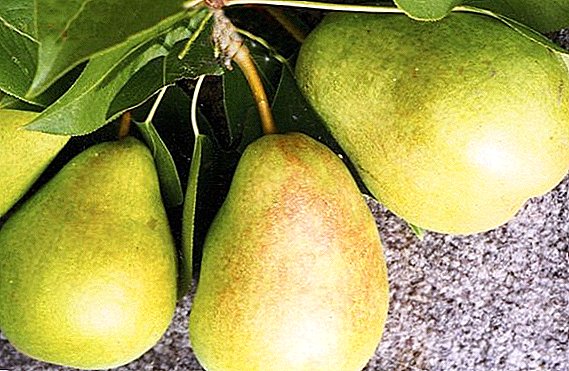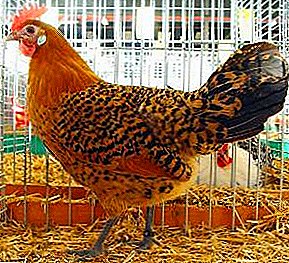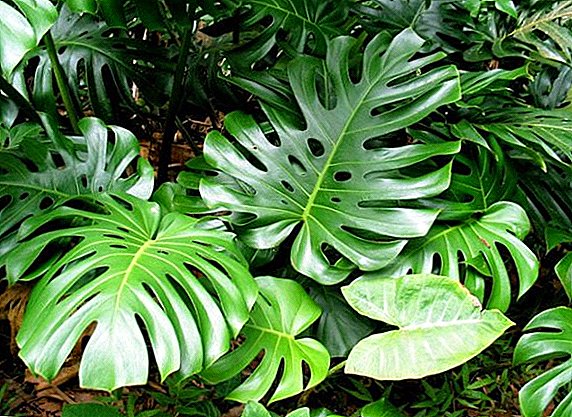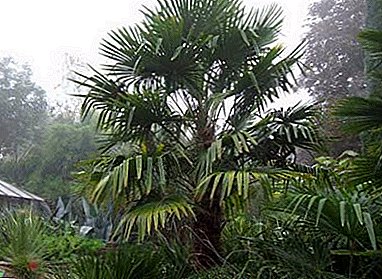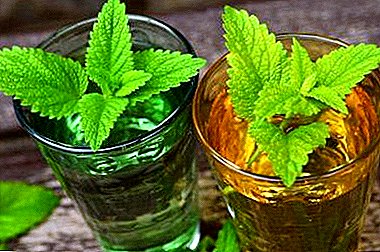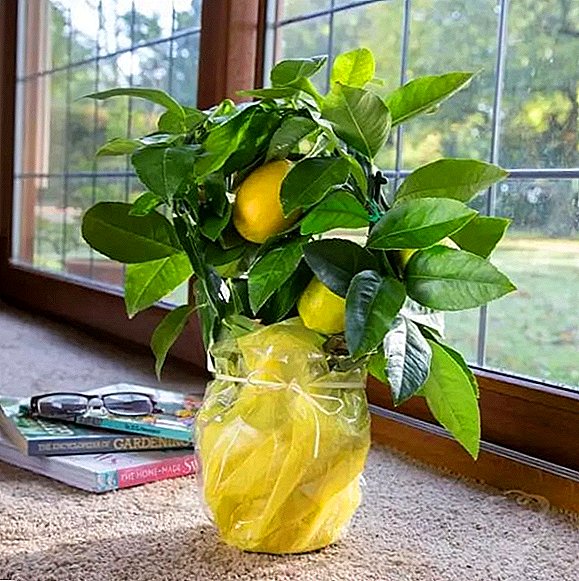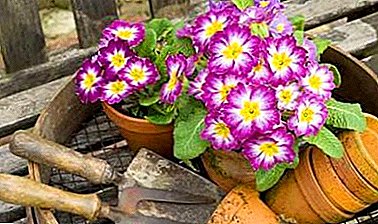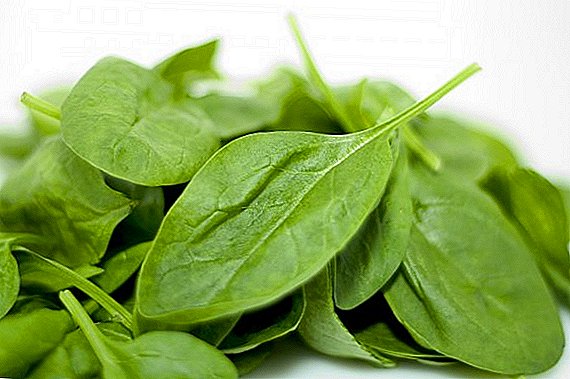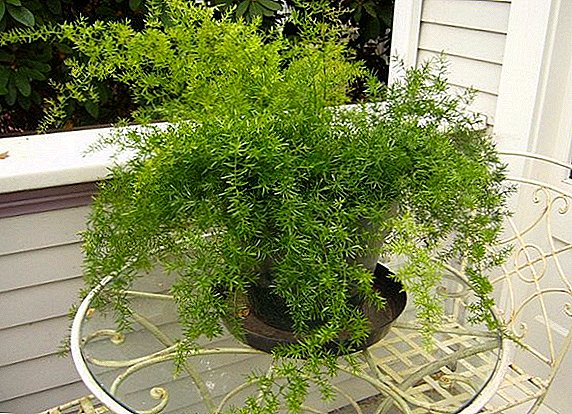 Asparagus Sprenger is a plant of the Asparagaceae family from the tropics of the Asian, African continents and South America. For a room type of plant and its fellows, home care should recreate the warm and humid microclimate of these regions.
Asparagus Sprenger is a plant of the Asparagaceae family from the tropics of the Asian, African continents and South America. For a room type of plant and its fellows, home care should recreate the warm and humid microclimate of these regions.
Description and photo view
Asparagus Sprenger, or Ethiopia asparagus, is one of the most popular species of this evergreen perennial plant. It is placed in apartments, offices and office premises, winter gardens.
Familiarize yourself with the intricacies of caring for indoor plants such as toreenii, ktenanta, kufeya, singonium, gloriosa, ripsalis, columneya, pittosporum, xanthosoma, aukuba, gynura, gemantus.
Thick creeping branches are covered with fluffy cladodes, spread to the sides and reach 1.5 meters in length. False leaves of soft green color cover shoots along the entire length, most of them are collected in bundles of 3-4 pieces, which makes asparagus Shprenger highly decorative. 
Flowering time - May, June. Bunches of miniature white flowers have a delicate pleasant aroma. As a result of pollination, small round berries of red color are formed and ripen. Fruits of asparagus Shprenger suitable for growing from seeds of new plants.

Did you know? A feature of the genus is that these leaves are very tiny, and instead the plant is covered with cladodia - modified stems, like soft needles, which serve as leaves.
Growing conditions
The plant is unpretentious and durable, but for the development and maintenance of a spectacular appearance it is necessary to observe several conditions.
Lighting
Ideal for Ethiopian asparagus scattered bright lighting, although short-term exposure to direct sunlight does not harm it. It is better to place the flower on a shelf, stand, cabinet or in hanging pots near the window. A location away from the light source can cause:
- stretching shoots;
- loss of cladode density;
- decrease the brightness of the color.

Important! Berries of representatives of this family are poisonous. Not allowed their ingestion.
Temperature
The temperature of + 10 ° C is critically low for a flower. Optimum temperature:
- in summer - 28-20 ° С;
- in winter - 18-14 ° C.
Air humidity
With a lack of moisture in the room, asparagus turns yellow and showered: the simplest thing to do for prevention is to spray the plant. In dry and hot weather, you need to do it 2 times a day, morning and evening. If space permits, put a pot with a tray in a wide shallow container with expanded clay, perlite or gravel, where a little water is poured. Evaporating moisture will gradually saturate the air.
The soil
For asparagus, the soil must meet the following requirements:
- neutral acidity;
- nutrient saturation;
- friability.

Suitable ready-made mix for indoor flowers with the addition of vermiculite or perlite. These components improve water and air exchange, prevent soil rotting.
Important! The use of wide flowerpots will allow better development of the root system of the flower.
How to plant asparagus: reproduction
For asparagus Sprenger, reproduction is available in any of the 3 ways - seeds, processes, cuttings.
Seeds
Before you grow asparagus from seeds, prepare a mixture of equal parts of sand and peat.
In late February, ripened seeds are sown in a prepared soil under a transparent cover. It is necessary to maintain the air temperature of 21-22 ° C. The crops are regularly aired, the soil is slightly moistened, if necessary, by spraying from a spray bottle. Seedlings will appear in 4-5 weeks, when reaching a height of 10-12 cm, they pick a seedling. In June, the seedlings are transplanted into permanent flowerpots.

Dividing bush
When transplanting, the rhizome of asparagus can be neatly divided into several parts, at least 3-4 healthy shoots, each of which should be planted in a separate pot.
Important! Tubers on asparagus roots are nothing but a supply of nutrients. Try not to damage them during transplantation.

Cuttings
Rooting cuttings are cut in lengths of 10-12 cm, rooted in containers with moist sand, covered with a transparent cap. Airing daily, provide good lighting and the temperature is not lower than 21-22 ° C. After 35-40 days, the cuttings are ready for planting in the ground.
Home care
With all the simplicity, the care of asparagus has a number of subtleties; it includes, in addition to watering and pruning, regular transplantation and plant nutrition.
Watering
The plant is sensitive to soil acidity, so chlorinated water is not suitable for irrigation and spraying. Optimally watered with separated, filtered or boiled water at room temperature. Although asparagus Sprenger has no pronounced rest period, watering is reduced in winter and increased in spring and summer. Watering should be abundant, but you can not flood the plant: stagnation of water in the pan is not allowed.
Important! In modern floriculture, instead of sand for germinating seeds and cuttings, vermiculite is used - a natural hygroscopic material that inhibits the development of mold and rot.

Top dressing
In the spring and summer, complex fertilizer is applied to the soil for indoor plants once in 14 days, in the cold season - once a month.
Asparagus feeding is carried out throughout the growing season, except for the rest period. For this purpose, liquid forms (biohumus, humates, etc.), mineral and organic fertilizers (ash, chicken manure) are used.
Pruning
Pruning allows you to stimulate the growth of young shoots and simulate the shape of a bush. Clipped shoots stop growing. Be sure to for aesthetic purposes and for the prevention of diseases remove dried, showered shoots.
Transfer
Up to 5 years, the plant requires an annual spring transplant, as it is actively growing. Bushes older than 5 years transplanted in 2-3 years. Overgrown specimens are transplanted into larger pots or divide the rhizome into several bushes. 
Did you know? Asparagus looks spectacular not only in a pot, but also in bouquets, highlighting the beauty of roses, gerberas, chrysanthemums.
Diseases, pests, possible difficulties
Diseases are most often caused by root rot from over-irrigation. Help to improve the flower:
- transplanting to fresh nutritious soil;
- removal during transplantation of old and rotten underground parts;
- watering correction;
- dosage application of suitable biostimulants.
- air humidification;
- regular removal of dry and old shoots.
Also asparagus can affect thrips, aphids and mealybugs.

When pests appear, they are recommended to be removed mechanically and with the use of insecticides.
Did you know? Asparagus is the Latin name for asparagus. And indeed - these ornamental plants are close relativesand vegetables. Asparagus as a garden plant people grow 2500 years.
Yellowing and shedding of shoots, except for dry air, can be caused by:
- old age of the shoot; branches older than 1.5-2 years are cut out;
- an excess of direct sunlight - if you can not put the flower in another place, it pritenyuyut;
- narrowness of the pot. Overgrown roots do not tolerate cramped, prone to decay. Transplanting to a larger pot or splitting a bush is recommended.

Caring for a plant does not require large expenditures and special skills, its spectacular ampelous shoots will decorate any interior.


